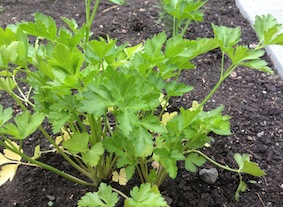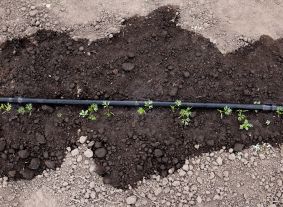Grow Perfect Parsley
Views: 7681

What I like about parsley in my garden is this: No matter how the rest of my crops are doing, parsley will brighten my outlook.
Now, mind you, many herbs are of the live-and-let-live sort. Plant them and don’t worry about them until you need to snip snip snip for making a vinaigrette or dress some fish. Thyme, for example, is just sort of there, its dark-grey-green leaves not really drawing my attention. Oregano, too, until it flowers for a moment.
Parsley, though, is brilliant in its greenness, in its ability to catch my attention not only with its color but also its movement. At full height it’s up to my knees and catches the summer breeze now and then. It sounds like I’m talking about an ornamental now, doesn’t it?
Let’s not forget, though, that it is tasty as well as beautiful. That combination gives it the honor of being placed as a finishing touch on many a restaurant dish. Fish, pasta, soup—they all benefit from a sprinkling of chopped parsley.
Biennial Parsley
Parsley, a member of the carrot family, is a biennial. That means it’ll put out vegetative growth its first year, overwinter, then flower in its second year.
Portions of my hedge do survive my Zone 6 winter and come back the following spring. But I prefer to plant new parsley every year—I just feel it puts out more leaves on a continual basis in its first year of growth.
Growing Parsley
I have great success with parsley because I have a rich, well-drained soil. It likes to be in moist soil—not wet but moist. It’ll let you know it’s too dry by showing yellow on its leaves.
I plant transplants in mid to late April in my area. Days are cool, nights can be brisk. Parsley can hold up pretty well in those conditions. Plant on a cool or cloudy day to minimize shock. I also throw a handful of compost into each hole as I plant to give them a nutrient boost.
I begin fertilizing the parsley along with the rest of the crops in late May until about end of July, using an all-purpose liquid fertilizer. That gives the parsley plenty of nutrition for the rest of the season.
Harvesting
In June, parsley really begins to grow vigorously. I hold off harvesting until I feel the plant won’t suffer in its growth from my stealing some stems. You’ll find yourself harvesting perfectly fresh and fine parsley leaves even after the first frost. These plants really do hold up well.
Consistent cold will eventually catch up to the leaves, though. A small warning: If you do remove your parsley plant at the end of the season, you’ll find it to be a bit of a tug-of-war. Like any member of the carrot family, it has a taproot. The bigger the plant, the bigger the taproot. I’ve had massive parsley taproots that could only be removed by using a shovel or pitchfork.
Meet Ellen Wells
When you’re raised on a farm, you can’t help but know a thing or two about gardening. Ellen Wells is our expert on edible gardening.…
Ellen's Recent Posts

Asparagus






